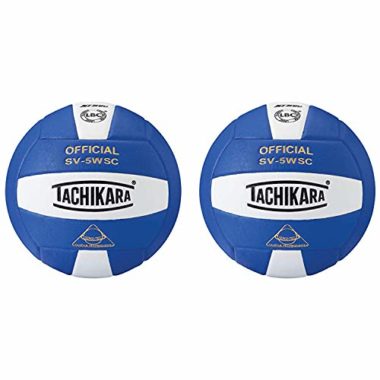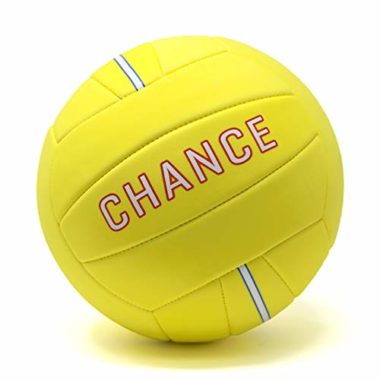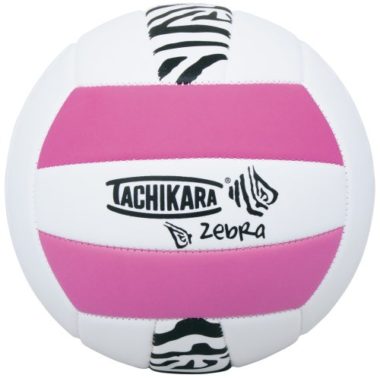
-
1.
-
2.
-
3.
-
4.
-
5.
Beach volleyball is a fun and active sport that many of us enjoy in the summertime. A great thing about it is that it doesn’t require much equipment – you just need to find an empty court and have a good ball with you.
While it’s allowed to use any ball on the court, a true beach volleyball will take your experience to a new level and make you feel like a pro. The best outdoor volleyballs are easy to control, go soft on your hands, and resist sand, water, and sun really well.
To help you find the perfect ball for you and your friends, we’ve created a buying guide that discusses everything a good model should have. But before we jump into it, take a look at our list of volleyballs that are guaranteed to make your summer unforgettable.
OUR TOP PICK
Tachikara Sensi-Tec Beach Volleyball

- What Makes This Beach Volleyball Stand Out
- Microfiber composite construction for improved durability
- Butyl bladder prevents air loss from the ball
- More than 40 color options available
Size: Official (26-27in circumference)
Material: Sensi-Tec composite
Weight: 9.1 to 9.8 ounces
Color: Blue/White (countless other options available)
EDITORS CHOICE
Wilson Graffiti Beach Volleyball

- What Makes This Beach Volleyball Stand Out
- Soft sponge layer prevents stinging when playing
- Machine-sewn for better performance around water
- Eye-catching colorful design looks great on the beach
Size: Official
Material: Sponge-backed synthetic leather
Weight: 9.1 ounces
Color: Multicolor
BEST VALUE
Wilson Soft Play Beach Volleyball

- What Makes This Beach Volleyball Stand Out
- Soft Play technology goes easy on your hands
- Machine-sewn construction with 18 panels
- Excellent durability on the sand and in water
Size: Official
Material: Sponge-backed synthetic leather
Weight: 12 ounces
Color: White, Yellow
Molten Recreational Beach Volleyball

- What Makes This Beach Volleyball Stand Out
- Soft polyurethane cover increases comfort in play
- Excellent for recreational use and practice
- Suitable for both indoor and outdoor use
Size: Official
Material: Synthetic leather with PU cover
Weight: 9.6 ounces
Color: 20+ color options available
Chance Soft Beach Volleyball

- What Makes This Beach Volleyball Stand Out
- Fully waterproof synthetic cover
- High-quality stitching keeps water out
- Money-back guarantee with the purchase
Size: Official
Material: Sponge-backed synthetic leather
Weight: 11.4 ounces
Color: Teal, Yellow
Wilson Cast Away Beach Volleyball

- What Makes This Beach Volleyball Stand Out
- Iconic Wilson design from the movie Cast Away
- High-quality synthetic leather resists wear and abrasion
- Butyl bladder keeps air from leaking out
Size: Official
Material: Synthetic leather
Weight: 8.8 ounces
Color: White/Red (Wilson)
Mikasa VLS300 Official FIVB Beach Volleyball

- What Makes This Beach Volleyball Stand Out
- Official FIVB game ball (used at the Olympics too)
- Color combination makes it easily visible
- Designed with reinforced panels to maintain the ball shape
Size: Official
Material: Soft composite
Weight: 7.8 ounces
Color: Blue/Yellow/White
Spalding King of the Beach Volleyball

- What Makes This Beach Volleyball Stand Out
- Official volleyball in all US-based tournaments
- Smooth and soft surface for easier play
- Additional lining to maintain shape and durability
Size: Official
Material: Microfiber composite
Weight: 1 pound
Color: White/Black
Vetra Soft Touch Beach Volleyball

- What Makes This Beach Volleyball Stand Out
- High-quality PVC coating for improved abrasion-resistance
- Soft touch technology improves grip and feel
- Designed to work well for both indoor and outdoor use
Size: Official
Material: PVC
Weight: 12 ounces
Color: Blue/Red/White, Yellow/Blue/White
Tachikara No Sting Beach Volleyball

- What Makes This Beach Volleyball Stand Out
- Foam backing eliminates stinging on the hands
- Tough construction with machine-stitched seams
- Playful and colorful zebra pattern
Size: Official
Material: Synthetic leather with foam backing
Weight: 9.6 ounces
Color: White/Pink/Zebra
How To Choose A Beach Volleyball – Buying Guide

Softness and Inflation Level
Compared to standard indoor models, beach volleyballs are a bit softer. You probably know that playing and moving on the sand is significantly different than playing on a hardwood floor, so a softer ball goes more gently on the hands and makes the game more dynamic.
As you’ll see later, many models come with a foam layer under the cover to dampen the impact when the ball hits your hands. In addition, a beach volleyball is also softer because it’s usually inflated less than standard indoor volleyballs.
Depending on the model, your ball will come partially or completely deflated, so you’ll need to inflate it before you can play. In case you’re wondering, the standard inflation pressure for beach volleyballs is 2.5 to 3.2 PSI (depending on how hard you want the ball to be).
Ball Size and Weight
To make things easier for players, beach ball size is pretty standardized. In relation to this, all of the balls featured in our reviews come in this official size, as determined by the FIVB (the governing body for world volleyball).
The exact dimensions of a standard volleyball are 26 to 27 inches in circumference (66 to 68 centimeters). While not that common, non-standard ball sizes also exist. These are usually larger and can be found among kid’s beach balls. However, along with the increased size, these are usually designed to be lighter than normal.
As for the weight, FIVB says that a standard beach volleyball should weigh around 9.5 ounces. But, like you’ve had the chance to see in our reviews, variations from the standard are much larger here. We can’t tell you which one to get, as this comes down to your preference. For reference, a heavier ball can go faster but it also hurts more when it hits your hands.
Materials and Construction Quality
Both indoor and outdoor volleyballs are usually made of composites (synthetic leather and various additions). However, the materials are not exactly the same. Because beach volleyballs are used in a harsher environment (with plenty of sun, sand, and salt water), they need to be tougher than an indoor ball.
To further improve performance on the beach, many high-quality outdoor volleyballs come with an additional PU coating on top of the composite cover. Additionally, the panels on a beach volleyball should be stitched instead of glued, providing a much higher resistance to wear and tear on the sand.
You might also like: Top Beach Balls
Indoor vs. Outdoor Use
A great thing about buying a well-made outdoor volleyball ball is that you can use it pretty much anywhere. While there are several differences between indoor and outdoor models, you probably won’t mind using beach volley balls inside (unless you are a pro).
As we mentioned, a beach volleyball has a bit different design – it’s softer and larger. Because of this, it will perhaps make more noise on hardwood flooring and won’t go as fast. However, most players don’t have a problem with this and choose a beach volleyball mostly for the versatility and durability it brings.
Professional vs. Recreational Use
When you start searching for a beach volleyball, you probably have a good idea of how and where you’re going to use it. If it’s mainly for relaxed beach games every now and then, most balls from our list will suit you just fine and you can choose based on how the ball looks.
On the other hand, if you’re a serious player who needs a ball for competing and practice, you should pay attention to a larger number of details. In this case, we recommend that you go with a more professional model that’s made of highest-quality materials and has an official size and weight (like the Mikasa VLS300 or Spalding King of the Beach).
FAQs

Q: What Are Beach Volleyballs Made of?
Most beach volleyballs are made of synthetic leather (composite material containing butyl rubber and resin polymer fiber). This combination makes the balls resistant to sand abrasion and water. Underneath the cover, many models have a foam layer that softens the impact.
At the center, every ball has an inflation bladder. In beach volleyballs, it’s made of either butyl rubber or PVC, with butyl offering better performance because it leaks less air (the ball stays inflated longer).
Q: Which Is Softer: A Beach Volleyball or an Indoor Volleyball?
Beach volleyballs are generally softer. There are two reasons for this – construction and inflation pressure. As we said, beach volleyballs often have a foam layer under the cover. On top of this, they are inflated less so they perform better on the sand (2.5-3 PSI compared to around 4.5 PSI)
Q: What is the official size and weight of a volleyball?
The official size of a beach volleyball measures between 26 and 27 inches in circumference, which is only slightly larger than a standard indoor volleyball. As for the weight, a beach volleyball usually weighs between 9.2 and 9.9 ounces (the same as an indoor ball).
Q: Are Volleyballs Waterproof?
This depends on the ball you get. Most indoor volleyballs are not waterproof – they will become saturated with water over time, heavy and soggy. On the other hand, the best beach volleyballs are usually made of composite materials with different stitching that makes them waterproof and prevents these problems.
Globo Surf Overview
Regardless of how you plan to use them (recreation or competition), beach volley balls should be easy to control, soft on your hands, and durable around sand and water. We hope that you’ve found our guide and reviews useful, so you can easily pick a volleyball that you can enjoy for many seasons in the sun.
More Beach Reviews:
- Aloe Vera Gel
- Beach Bag
- Beach Canopy
- Sun Hat
- Beach Blanket
- Sun Protective Clothing
- Tanning Oil
- Board Shorts
- Beach Cooler
- Beach Bag Essentials
What kind of beach volleyball did you play games with so far? Do you have a favorite kind or do you remember a type of volleyball that really made an impression on you? What kind of beach volleyball do you plan to buy? Share your experience with the Globo Surf community by leaving a comment below.

